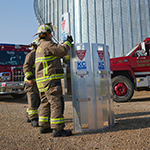Keep your eyes on the road and your mind focused on driving
Most drivers agree that many accidents are the result of one or more drivers not paying full attention to their driving duties. Lack of attention results in the driver not being able to respond appropriately to changing driving conditions. Driver inattention often falls into the following four categories:
Taking eyes off the roadway ahead
From bustling interstates to scenic rural roads, there are many distractions vying for our attention, diverting a driver’s gaze from the road ahead. While tempting, drivers who are not focused on driving increase their risk of getting into an accident. Even checking mirrors and blind spots can be dangerous if not done quickly.
According to a study by the National Highway Traffic Safety Administration, drivers are advised to keep their mirror and blind-spot scanning within 1.5 seconds. To achieve this, drivers should establish a consistent scanning routine that involves checking both left and right mirrors and blind spots. Always scan ahead before shifting focus to the next area. In situations where drivers need to divert their attention from the road—such as searching for a building address—they should increase their following distance and limit their searches to less than 2 seconds.
Performing secondary tasks
Performing secondary tasks, such as reading a map or using a cellphone, divert your eyes and mind away from your driving duties, often for several seconds. A Federal Motor Carrier Safety Administration study1 on distracted driving among truck drivers found, not surprisingly, that performing the following secondary tasks increases your crash risk:
- Four times while reading
- Six times while dialing a cellphone
- Seven times while looking at a map
- 10 times while doing tasks such as cleaning the side mirror, rummaging through bag
- 23 times while texting
All these distractions are totally under the driver’s control. The Federal Motor Carrier Safety Administration wisely banned texting and hand-held cellphone use for commercial motor vehicle drivers. Why? Because these activities divert a driver’s attention for extended periods, often four seconds or more. Now, four seconds might not sound like much, but at 60 miles per hour, a truck can cover 352 feet—that is more than a football field!
Daydreaming
Daydreaming is also a form of driver inattention. Drivers spend so much time on the road it is not surprising that they periodically begin daydreaming. While daydreaming, the driver’s eyes may be seeing what is happening, but the mind is not processing the information. How many times have you snapped to on the roadway, not remembering the last couple of miles? If you find your mind wandering, quickly refocus on the driving situation — scanning, anticipating, and adjusting to the traffic around you.
Fatigue
Drivers understand that driving while severely fatigued can be dangerous, but moderate drowsiness can also impact a driver’s ability to recognize and respond to hazards. The National Highway Traffic Safety Administration2 has found that driving while moderately or severely drowsy increases your crash risk by nearly 6 times. Drowsy driving can occur during the day as well as at night. Drivers who become drowsy should immediately find a safe place to park and get adequate rest.
References
[1] “Disraction in Commercial Trucks and Buses: Assessing Prevalence and Risk in Conjunction with Crashes and Near-Crashes” (Document No. FMCSA-RRR-10-049), Federal Motor Carrier Safety Adminisration (September 2010).
[2] “Driver Disraction in Commercial Vehicle Operations” (Document No. FMCSA-RRR-09-042), Federal Motor Carrier SafetyAdminisration (September 2009).
[3] “The 100-Car Naturalistic Driving Study: Phase II — Results of the 100-Car Field Experiment (Document No. DOT (Department of Transportation) HS 810 593), National Highway Traffic Safety Administration (April 2006).

 >
>

 >
>
 >
>